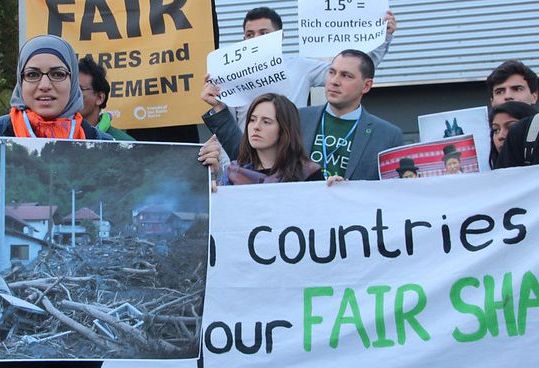The US should be paying nearly $40bn towards the $100bn climate-finance target, new Carbon Brief analysis shows. This is $32bn more than the estimated $8bn it actually gave in 2020.
Other laggards include the UK, Canada and Australia, which all made smaller financial contributions to the internationally agreed target than their shares of historical emissions.
The analysis compares national shares of historical emissions with proportionate contributions to the $100bn climate finance target. Developed countries agreed at the COP15 climate summit in 2009 to deliver this funding by 2020.
The US, for example, is responsible for 52% of the historical emissions added to the atmosphere by Annex II countries. This is the list of “developed” or “industrialised” nations legally obliged to give climate finance under the terms of the UN climate convention.
If the US were to have paid an equivalent “fair share” of the $100bn climate finance target then, after accounting for private-finance contributions, it should have given $39.9bn.
In reality, it only gave $7.6bn (19% of its fair share) in 2020, the most recent year for which data is available.
Similarly, Canada gave 37% of its fair share and was $3.3bn short, while Australia gave 38% of its fair share and fell short by $1.7bn. The UK gave 76% of its fair share, falling short by $1.4bn.
Germany, France and Japan gave proportionally more than their contribution to historical warming. Unlike others, however, much of their finance is in the form of loans rather than grants.
Fair shares
Developed countries at UN climate negotiations agreed in 1992 to provide “new and additional financial resources” to help developing countries tackle climate change.
This was based on the relatively wealthy “Annex II” nations having both greater capacity to cope with the challenges ahead and greater historical responsibility for causing climate change.
(Inclusion in Annex II was based on membership of the Organisation for Economic Co-operation and Development (OECD) at the time, including western European nations, the US, Canada, Australia, New Zealand and Japan. As such, it does not include large economies such as China.)
At that point they were responsible for 46% of cumulative historical carbon dioxide (CO2) emissions from fossil fuels, industrial processes, cement, land use, land use change and forestry. As of 2020, they were still responsible for 40% of the global total.
Their climate-finance obligation was given a tighter focus in 2009, when they said they would “mobilise $100bn per year by 2020” so as to “address the needs of developing countries”. But they have failed to meet this goal and are not expecting to do so until 2023.
In 2020, only $83bn of climate finance was given, including $60bn in bilateral country-to-country aid and contributions via development banks, plus $23bn from climate funds and private sources.
There are no official numbers for each countries’ contribution to this $83bn total. However, Carbon Brief has estimated their contributions (see methodology below). These contributions can be compared with each nation’s share of historical emissions, previously calculated by Carbon Brief.
See original article for graphics and methadology.

